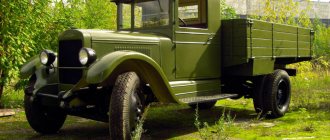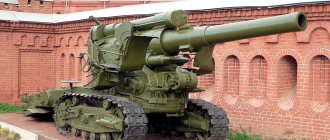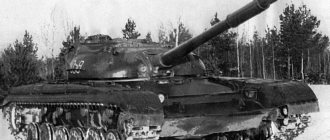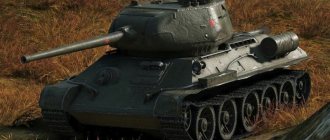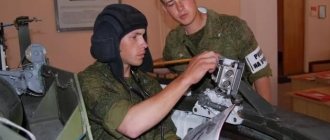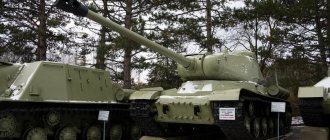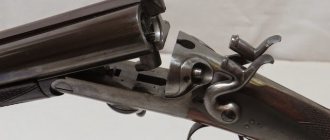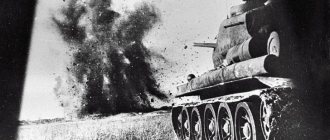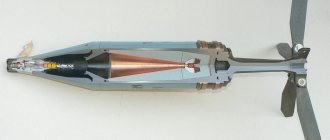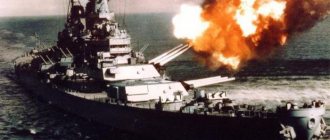| M1932 (19-K) 45 mm | ||
| 45mm M1932 (19-K) from the Parola Tank Museum. | ||
| Type | anti-tank gun | |
| Country of origin | Soviet Union | |
| service history | ||
| operators | Red Army | |
| wars | The Second World War | |
| production history | ||
| Creator | Factory No. 8 | |
| Produced | 1934–1937 | |
| Quantity | +21.564 | |
| options | Tank gun 20-K 45-mm anti-aircraft gun 21-K | |
| Characteristics | ||
| Weight | 450 kg (towed by horse) 510 kg (towed by car) | |
| Length | 6.4 m | |
| barrel length | 2.070 mm D/46 [ 1 ] | |
| Team | 4 | |
| Ammunition | 45 x 310 RUR [2] | |
| Caliber | 45 mm | |
| shooting system | Semi-automatic vertical sliding wedge | |
| Recoil | hydraulic shock absorber and spring | |
| Front | forked [ 1 ] | |
| portrait angle | -8° to +25° | |
| horizontal angle | 60° [ 1 ] [ ] | |
| rate of fire | 15 rounds per minute | |
| maximum range | 4.400 m [ 1 ] | |
| Charger | manual feed | |
| Maximum speed | 760 m/s | |
| [edit data in Wikidata] | ||
M1932 ( factory
designation
19-K,
index GRAU
52-P-243A
) is a rapid-firing light anti-tank gun used in the interwar period and in the initial stages of Operation Barbarossa. It was created by the engineering team of Plant No. 8, located in the city of Korolev, headed by Vladimir Mikhailovich Bering.
Story
A gun with the factory designation 19-К ( 19-К
in Cyrillic) was a combination of a modified 37 mm M1930 (1-K) mount (built under license from Rheinmetall) with a 45 mm gun developed in March 1932 [4] and adopted by the Red Army on March 23, 1932 [ 5 ]The reason for choosing the 45 mm caliber was due to large quantities of French 47 mm shells, which could be converted into 45 mm by turning rotation bands from them.
The resulting manually locked anti-tank rifle turned out to be ineffective due to low mobility and problems with reliability, therefore, after a number of modifications (including the arrest of the chief designer of the project on August 10, 1933 when various design flaws were discovered) production was again sent to field tests on December 26, 1933 . The resulting semi-automatic breech-loading gun was designated "45 mm anti-tank gun M1934" (45 mm anti-tank gun Model 1934. These guns were declared obsolete in 1937 and replaced by the 45 mm anti-tank gun Model 1937 (53-K). Tank version (45 mm tank gun Model 1932/38 (20-K), in Russian) was still in service in the early stages of Operation Barbarossa. The 45 mm guns Model 1932 (19-K) captured by the Germans received designation 4.5 cm Pak 184(r)
[1]
In 1934, its carriage had its wooden-spoke wheels replaced with those with metal tires from the GAZ-A, and in 1936 the wheels were upgraded with solid rubber tires, increasing the total weight of the gun to 560 kg. The evolution from the 19-K to the 53-K was gradual, with product lines being improved at different times.
tank gun 20-K
Detail of the breech and bolt 20-K from the Tank Museum in Kubinka.
The gun was installed on side tanks under the designation M1932 (20-K) 45-mm tank gun
.
In 1934, the barrel was upgraded with a semi-automatic action in place of the original manual action. Other changes affected the lifting mechanism and the recoil system. It was used on several Soviet tanks and fired the same rounds as the anti-tank version. Later, the gun was improved and received the designation 45-mm tank gun M1938.
, equipped with an electric shock system and an optical sight with a TOS stabilizer (only in the vertical plane), which made it possible to conduct accurate fire while the tank was moving.
The gyroscopic stabilizer was removed in 1941 because inexperienced crews did not activate it. Between 1941 and 1942, some M1938 tank guns were installed on mounts to replace anti-tank guns lost in the early stages of Operation Barbarossa. Although the Soviet designation for these guns is unknown, the guns captured by the Germans were designated 4.5 cm Pak 184/6(r)
. [ 1 ]
| Year | Units produced |
| 1932 | 10 |
| 1933 | 2099 |
| 1934 | 2005 |
| 1935 | 2443 |
| 1936–40 | 15007 |
| 1941 | 2759 |
| 1942 | 5090 |
| 1943 | 3040 |
Armored vehicles and tanks armed with this gun include:
- BA-6
- T-26
- BT-5
- BT-7
- T-18M
- T-50
- T-70
- T-35
- QMS
Anti-aircraft gun 21-K
The 19-K barrel was mounted on a pedestal and was used by the USSR Navy as an anti-aircraft gun from 1934. It was not very effective in this role, as it had to be reloaded manually, which reduced its rate of fire. up to 25-30 rounds per minute, moreover, their shells did not have a time fuse and had to strike directly to damage the target.
THE TANK THAT FACED WAR
The first meeting of these armored vehicles took place in rebellious Spain in 1936. In September of this year, 41 German Pz-1 tanks arrived here.
A month later, 50 T-26 tanks were delivered on the Komsomolets steamship. In the very first combat contacts, a significant advantage of Soviet vehicles was revealed. The 45-mm 20K cannon penetrated through Pz-1s at any range, which only had a pair of 7.92-mm machine guns, which was of little danger to our vehicles - the T-26’s armor was also more powerful. In 1938, the Germans sent here their new Pz-IIs, which had 20-mm cannons and slightly increased armor. However, they were also unable to fight our tanks, which hit them at a range exceeding even one kilometer. Pz-\\ could respond only from a short distance, and then only with a successful hit.
By that time, no other country had created a tank equal to our T-26. “It was a magnificent tank for its time: a low silhouette, easy to manufacture and operate, well armed and protected for its size,” said the famous military historian P. Chamberlain.
The T-26 light infantry tank was put into service in 1931, but serial production began only in 1933. Work on such a tank began with the Decree of the Central Committee of the All-Union Communist Party of Bolsheviks “On the State of Defense of the USSR” dated July 15, 1929, which indicated on the need to develop new types of military equipment, including tanks. According to the plan of the Revolutionary Military Council, the army needed a tank that could “become the main striking force of mobile units in conditions of maneuverable combat.” The armament of such a tank was supposed to provide it with “superiority over all known combat vehicles of similar mass, and the armor would protect against rifle and machine-gun bullets at all distances, and at a distance of 1000 m - from the fire of 37-mm anti-tank guns.”
At that time, in the late 1920s and early 1930s, there were two concepts for the development of tanks in the world. Thus, the French preferred small, slow-moving escort vehicles, as well as heavy, heavily armored ones, necessary for breaking through defensive lines. At the same time, the British designed mainly fast, lightly armed ones. They were ahead of the French in reducing the vulnerability of armored vehicles on the battlefield. In May 1930, military experts from the Department of Mechanization and Motorization of the Red Army, apparently considering the English concept more acceptable, entered into a contract with) for the supply of 15 double-turret Vickers-6-ton tanks.
Double-turreted T-26 early production with machine gun armament
T-26 tank with riveted hull and turret. Armed with a 45 mm 20K cannon and a 7.62 mm machine gun. Tank Museum, Parola, Finland
Cannon-machine gun tank with a 37 mm B-3 cannon and a 7.62 mm DT machine gun
These vehicles served as a prototype for the creation of the first versions of our TMM-1 and TMM-2 tanks. The first low-power tank TMM-1 was produced in 1931 as a modernized English version. Its body design was changed to accommodate a different engine - the American 6-cylinder Hercules ("Hercules") with a power of 94 hp. It replaced the English 4-cylinder 88-horsepower.
In addition to the two turret 7.69 mm Vickers machine guns (later they were replaced by 7.62 mm), a third 7.62 mm DT machine gun was installed in the front hull plate on the right in a ball joint. The crew was accordingly increased to four people.
The armor was strengthened, bringing the thickness of the frontal part of the hull to 20 mm, and the sides to 10 mm. As a result, the mass of the tank increased to 8 tons.
Ten TMM-1s were manufactured.
TMM-2 had a 37-mm cannon in one of the turrets, and the third course machine gun was removed. Therefore, the tank crew was again reduced to three people.
TACTICAL AND TECHNICAL CHARACTERISTICS OF THE LIGHT INFANTRY ESCORT TANK TMM-1 model 1932
TACTICAL AND TECHNICAL CHARACTERISTICS OF THE B-3 TANK GUN
ARMOR PENETRATION OF THE B-3 GUN (mm)
However, tests of the tanks did not show any advantages over the English Vickers. On the contrary, severe overheating of the American engine was revealed, which affected the mobility of already heavier vehicles, although the reinforced armor did not protect against artillery shells. The gearbox and turning mechanism did not work well. In September 1932, military experts refused to carry out further modernization of TMM tanks, directing production capacity to develop the tank under the designation T-26.
Meanwhile, since 1931, Leningrad has been producing double-turret machine-gun tanks according to English drawings. The only difference between them and the prototype was that they were intended to be armed with DT machine guns in ball mounts. By the end of 1931, 120 vehicles were manufactured, but due to low quality, none of them were initially accepted for military acceptance. Only after lengthy negotiations, according to various sources, 88 or 100 tanks were accepted, and 35 of them conditionally, since their hulls were made of non-armored steel. However, in September of the same year, the Defense Committee approved a production program for 3,000 T-26 units for 1932, although most production was still far from ready.
Linear gun tank T-26 mod. 1933 with a cylindrical turret with a 45 mm gun. To the right of the gun is a machine gun embrasure, the driver's workplace is on the starboard side.
The turret of a tank model 1933. In the center is the breech of a 45-mm cannon and its aiming mechanisms, on the right is a machine gun and a TOP sight, to the left of the gun is a PT-1 sight
In 1932, all tank production and the experimental design engineering department (OKMO) were transformed into the Leningrad State Plant No. 174 named after K.E. Voroshilov, who became a long-term supplier of T-26s to the army. In October, the People's Commissariat of Heavy Engineering established the Special Engineering Trust "for better organization of tank production." It included about 15 related enterprises. These included, in addition to plant No. 174, the Izhora plant, which produced armored hulls and turrets: “Red October,” which produced gearboxes and driveshafts; "Krasny Putilovets", responsible for the supply of the chassis; Plant No. 37, which supplied boiler-tin products and other components. It was planned to involve the Nizhny Novgorod Automobile Plant (future GAZ) and Joint Stock Moscow Company (AMO, future ZIL) in the production of engines.
By March 1933, Plant No. 174 managed to assemble 1,441 T-26 tanks, 950 of which immediately went to army units (according to other sources, by August 1933, 1,626 double-turret tanks were produced).
Since the first releases, changes have been constantly made to the design of the T-26. So, already in the fall of 1931, a cylindrical higher machine gun turret with an observation window was installed on it. Then the engine was moved 0.77 m to the stern to improve its operating conditions. True, for this it was necessary to lengthen the driveshaft, and also change the outlet and mounting of the muffler. Early next year they replaced the oil and fuel tanks with new ones. A box was placed above the air outlet blinds to protect the engine from precipitation.
Initially, the tank hull was riveted - riveting 6 - 13 mm sheets was done on the frame. But at the beginning of 1932, they managed to produce 22 vehicles with welded hulls, although they continued to produce solid-riveted hulls and turrets in parallel.
Light tank T-26:
1 - drive wheel; 2 — support roller; 3 - 45 mm gun; 4 — periscope sight; 5 — DT anti-aircraft machine gun; 6—reservation of the whip antenna input; 7 — stern DT machine gun; 8 — spare support rollers; 9 — air cap; 10 — guide wheel; 11 — suspension bogie; 12-ventilation hatch; 13.24-sapper shovel; 14-axe; 15 — hatch cover to the neck of the gas tank; 16 — spare parts box; 17 - jack; 18 — magneto and generator hatch cover; 19 — hatch cover to the necks of the oil and gasoline tanks; 20 — spare tracks; 21 — spare spring; 22 — engine access hatch cover; 23 - crowbar; 25 - saw; 26 — hatch cover for access to the onboard clutches and gearbox; 27 — double-leaf driver's hatch cover; 28 - signal; 29 — headlight; 30 — muffler; 31 — tow chain; 32 - blinds
Cannon and machine gun T-26 mod. 1932
Radium T-26 mod. 1936 with cylindrical turret
Radio tank T-26 with a handrail antenna of the shortwave radio station 71-TK-1
The layout of the tanks was classic for that time: the engine was in the rear, the transmission was in front. On the turret box of the hull there were two towers mounted on ball bearings. They could rotate independently of each other in a 240° sector, but in such a way that both towers could fire in both the front and rear sectors, equal to 100°, ensuring simultaneous firing from both sides.
7.62 mm DT-29 machine guns were placed in the ball joints of the front part of the turrets. They had a maximum sighting range of up to 1000 m with an effective range of 600 - 800 m; the combat rate of fire was 100 rounds/min. The machine guns were equipped with disc magazines with 63 rounds of ammunition. The bullets in the cartridges were armor-piercing, tracer, and armor-piercing tracer. Ammunition - 6489 pcs. in 103 discs. Aiming the machine guns was carried out very simply - with shoulder rests; The rotation of the turret was carried out by single-stage rotation mechanisms.
The turrets, frontal part of the hull, and sides had armor plates 13 mm thick, the roof - 10 mm, and the bottom - 6 mm. In 1932, the armor thickness was increased to 15 mm. The weight of the tank reached 8.2 tons.
The engine was installed T-26 - a 90-horsepower gasoline, 4-cylinder air-cooled engine with a special fan, which allowed it to reach highway speeds of up to 32 km/h. The specific power of the tank is -11.2 hp/t.
The gas tank held 182 liters of high-grade (for that time) gasoline with a cruising range of 140 km.
The power transmission consisted of a single-disc main dry friction clutch. The five-speed gearbox was located in the front of the tank - the driveshaft from the engine passed through the entire body; The gear shift lever was on the box itself.
The chassis had two bogies on board, consisting of four dual rubber-coated road wheels in each. The bogies were suspended on two quarter-elliptical leaf springs; the rollers were connected in pairs by balancers. The drive wheels with removable gear rims were front. Track chains made of chromium-nickel or manganese steel - 260 mm wide.
The T-26 machine gun crew consisted of three people: a driver, a left turret gunner, and a commander who combined the functions of a right turret gunner.
In 1932, in parallel with machine-gun tanks, they began to produce double-turret machine-gun-cannon tanks - now a Hotchkiss cannon was installed in the right turret; it was a model 1880 naval gun converted by the French - a variant for a tank. Our artillery designer P. Syachentov improved its firing and trigger mechanisms: in this form it was adopted for service in 1920 under the designation PS-1 (“Syachentov Gun-1”).
The gun had a 22.7 klb long monoblock barrel, a vertical wedge bolt, and a spring knurl. In the vertical plane it was aimed manually using a shoulder rest within +30°, in the horizontal plane - by turning the turret.
TACTICAL AND TECHNICAL CHARACTERISTICS OF THE 20K GUN. 1934
ARMOR PENETRATION CANNON 20K mod. 1934 PROJECTILE BR-240SP (mm)
CANNON AMMUNITION 20K mod. 1934
However, the gun had low efficiency when firing at both infantry and armored targets - solid cast iron shells, cast iron and steel grenades and buckshot served as ammunition. In 1932, its production was stopped.
In the same year, it was put into service under the name “37-mm anti-tank gun mod. 1930" and the factory index 1-K adopted the German 3.7-st gun PaK 35/36. . The same designer P. Syachentov developed a project for installing its swinging part in a tank - the result was the PS-2 tank gun. Already on its basis, a new version of the 37-mm cannon was developed, designated B-3 (index - 5-K); it had a smaller recoil and knurl size, which made it possible to install it in the standard T-26 turret.
The weight of the machine-gun-cannon tank increased to 8.7 tons with 15 mm armor on the frontal part of the hull and sides. The ammunition load in such a vehicle was 113 pieces, 7.62 mm cartridges - 3528 pieces.
In May 1932, the 45-mm cannon model was adopted to replace the 37-mm anti-tank gun. 1932 (index 20K), and later - its modernized version 20K mod. 1932/34 In terms of armor penetration, it had characteristics comparable to the 37 mm, but its 0-240 high-explosive fragmentation projectile turned out to be much more powerful due to an increase in the mass of the explosive (from 22 g to 118 g). This made it possible to use the tank much more effectively in the fight against enemy personnel, and therefore as an escort and infantry support vehicle.
However, the 20K gun was relatively large and did not fit in the existing T-26 turrets. To do this, it would be necessary to introduce a balancing mechanism, a new lifting guidance mechanism, leaving only one crew member in the turret. Therefore, in March 1933, at plant No. 174, a new cylindrical turret with an outer diameter of 1320 mm with an increased internal volume and an aft niche formed by the continuation of the side plates of the turret was installed on the T-26 hull as a counterweight; The niche also served for stowing ammunition.
In the roof of the turret there was a hatch for the crew to get in and out, and in a niche there was a hatch for dismantling the gun.
The cannon, coaxial with a machine gun, was placed on trunnions in the frontal part of the turret, with a massive mantlet. It had a barrel length of 46 klb (2070 mm) with a free replaceable pipe - liner, a vertical wedge shutter, recoil guards with hydraulic recoil brakes, and spring knurls. The rollback length was 245 - 275 mm.
The gun was aimed vertically by a sector mechanism with angles from -5° to +26°; in the horizontal plane, circular fire could be carried out by rotating the turret using a screw rotating mechanism. The gunner used a panoramic periscopic optical sight PT-1 mod. 1932 and a telescopic optical sight TOP mod. 1930 PT-1 had an aiming reticle designed to fire armor-piercing shells at a range of up to 3.6 km, fragmentation shells - up to 2.3 km, and a coaxial machine gun - up to 1.6 km. The TOP had the same grid, but designed for ranges of up to 6.4 km, 3 km and 1 km, respectively. The magnification of both devices was 2.5 times.
Gun 20K mod. 1932/34 the first series was semi-automatic - the automation only worked when firing armor-piercing shells. When firing high-explosive fragmentation weapons, only the bolt was automatically closed after inserting a projectile into the breech, while the bolt was opened and the cartridge case was extracted manually.
A unit of T-26 tanks before entering the concentration area. Khalkin-Gol, July 1939
The new semi-automatic inertia type and modified recoil mechanisms were only able to be installed by 1935.
The 20K cannon of the T-26 tank was intended to fire at armored targets and artillery pieces, and at enemy personnel (open and in shelters) with both armor-piercing and high-explosive fragmentation shells. It had excellent tactical and technical characteristics for that time. Thus, the maximum firing range was 4200 m with a direct shot distance of 3600 m. The BR-240SP armor-piercing projectile weighing 1.43 kg, having an initial speed of 760 m/s, at a distance of 500 m, penetrated armor 45 mm thick, and at 1500 m - 28 mm. The gun's rate of fire is 7 - 12 rds/min.
The main ammunition is armor-piercing: tracer BR-240, incendiary BRZ-240, caliber BR-240SP, as well as high-explosive fragmentation 0-240 and buckshot Shch-240.
The tank's ammunition consisted of 136 rounds and 2,898 machine-gun rounds in 46 magazines. 84 rounds were placed in the fighting compartment, 40 were located in the turret niche, and another 12 were placed directly in the turret itself along its sides. 40 machine-gun magazines were placed in boxes on the floor of the hull, another 6 were located on the right side of the turret in a special rack.
The hull of a single-turret tank was not much different from a double-turret one. The turret plate on which the turret was installed, shifted to the left, has changed. The fighting compartment was equipped with a fan, placing it on the right side near the roof of the fighting compartment, since during firing the concentration of carbon dioxide in the tank increased unacceptably.
TACTICAL AND TECHNICAL CHARACTERISTICS OF THE T-26 TANK
Since 1933, the T-26 began to be equipped with radio stations 71-TK-1 (later - 71-TK-2, 71-TK-Z) with a handrail antenna. This is a short-wave transceiver, telephone and telegraph station, the receiver and transmitter of which are made in the form of separate blocks. To protect against shaking, the receiver and transmitter were installed on special frames with shock absorbers. The stations allowed joint operation with tank intercoms.
The communication range by telephone was 10 - 30 km while driving and up to 40 km when parked with the engine not running. The transmitter was powered by a starter battery through an umformer and could operate continuously for 30 minutes, after which a half-hour break was required to cool down. The receiver operated from two dry anode batteries with a voltage of 80 V each and an alkaline battery; The duration of its operation from one set of batteries was 15 - 20 hours. The weight of the radio station was 60 kg.
The handrail antenna was a half-ring made of a metal pipe, mounted around the tower on insulating brackets. However, as it turned out, in combat conditions such an antenna unmasked radio-equipped command vehicles, and the enemy concentrated anti-tank fire on them. In the course of further modernizations, this type of antenna was abandoned in favor of a whip one.
In 1935, the plant completely switched to electric-welded hulls and turrets, and the gun mantlet began to be produced by stamping. In the same year, a second DT machine gun was placed in the rear turret on an additional ball mount. At the same time, the ammunition load was reduced to 102 rounds.
The following year, the tanks received a DT anti-aircraft machine gun on a P-40 turret mounted on the roof of the turret. Two powerful “combat light” spotlights were placed on the mask, designed for combat operations at night. The engine was boosted - maximum power increased to 95 hp.
In 1938, as a result of another modification, a conical turret appeared on the tank, welded from rolled armor sheets 15 mm thick. It was equipped with a 45-mm cannon mod. 1938 with an electric shutter, which made it possible to fire ammunition with an electric primer sleeve. The gun was equipped with a TOS telescopic sight, stabilized in the vertical plane. They installed two fuel tanks with a total capacity of 290 liters, increasing the range to 240 km. An emergency hatch appeared in the bottom of the tank.
In 1939, a turret box with inclined sheets was made and new blinds with enhanced protection were installed. Now they had removed the turret-mounted aft machine gun and again returned to the aft niche with the stacking of shots. The engine was brought to a power of 97 hp.
1940 - the year of the last, 23rd modification of the T-26. This time, 30-40 mm protective screens appeared on the tanks. They made it possible to withstand hits from 45-mm cannon shells at a distance of 400 - 500 m. The thickness of the turret box sheets was increased to 20 mm, and a new turret ring was installed.
Over all the years of serial production of T-26 tanks of various modifications, 11,218 units were manufactured. In addition, OT flamethrower tanks, TR armored personnel carriers, ST bridge laying vehicles, TB transporters, T artillery tractors, and SU and AT self-propelled artillery units were produced on the same chassis. As it turned out, the chassis was unified for a whole family of combat vehicles.
As part of the Red Army, T-26s first participated in the operation to repel the advance of Japanese troops into the territory of the USSR in the area of Lake Khasan in July - August 1938, where more than 250 of these tanks operated.
T-26 crew: on the left in the turret is the tank commander, on the right is the gunner, in the open hatch is the driver. Spotlights are installed above the gun mantlet for combat operations at night.
In May - September 1939, T-26s were used to resolve the military conflict on the Khalkin-Gol River. Thus, the tank battalion of the 36th motorized rifle division consisted of 50 vehicles. The 11th Tank Brigade consisted of OT-26 flamethrower tanks, and a separate tank company of flamethrower tanks had OT-130 tanks.
Since 1940, each rifle division had tank battalions with 54 T-26 vehicles (15 of them flamethrowers). Each rifle regiment had a tank company with 17 T-26 tanks. There were also light tank brigades armed with BTs or T-26s. With T-26 tanks there were 17 brigades of 267 units each. Seven tank regiments with T-26s of 164 vehicles each were also formed, which were included in some motorized rifle and motorized divisions.
As part of such units, T-26 tanks participated en masse in the Soviet-Finnish War of 1939 - 1940, showing high combat qualities.
According to the publication “Strategic collection No. 1. Combat and numerical strength of the Armed Forces of the USSR during the Great Patriotic War,” published in 1994, as of June 1, 1941, the Red Army had more than 9998 T-26 tanks of all modifications (about 40 % of the entire tank fleet of the Red Army), of which 8423 are serviceable. Together with the BT, they turned out to be the main tanks that resisted the advancing units of the German army in the initial period of the war, especially in the battles near Moscow. And here, as in Spain, the German Pz-I and Pz-II, produced even in recent years, could not match the level of our vehicles.
The T-26 completed its military service in the Soviet Army. In the army units that guarded our border with Japanese-occupied Manchuria during the war, many T-26 and BT tanks were preserved. These vehicles took part in the military operation to defeat the Kwantung Army of Japan in 1945.
The T-26 fully corresponded to its purpose. Its armament, maneuverability, and maneuverability fully met the requirements for light infantry tanks. There was nothing equal, or even close, in any other country at that time.
V. TALANOV
We recommend reading
- FROM THE WARDROBE - WALL From time to time, the furniture (and more often, individual items) in the apartment is updated, although the old one is not yet so outdated that it can be sent to a landfill. What should we do with it? Sell? Give?…
- A SMALL WINCH IS A GREAT INTEREST Following almost every piece of information published under the heading “VDNKh for Young Innovators,” the editor receives many letters. On the envelope are the addresses of NTTM participants, young innovators...
Performance
| Penetration [ 6 ] | |||||
| Type | 100 m | 500 m | 1.000 m | 1.500 m | 2.000 m |
| AFE | 61 mm | 46 mm | 32 mm | 22 m | 15 mm |
| APBC-HE | 59 mm | 45 mm | 35 mm | 29 mm | 26 mm |
| APKR | 94 mm | 64 mm | 40 mm | — | — |
Application
Used on the following combat vehicles:
- BA-3 is a medium armored vehicle.
- BA-6 is a medium armored vehicle.
- BA-10 is a medium armored vehicle.
- BA-11 is a heavy armored vehicle.
- T-26 is a light tank.
- T-50 is a light tank.
- T-70 is a light tank.
- T-80 is a light tank.
- BT-5 is a light wheeled-tracked tank.
- BT-7 is a light wheeled-tracked tank.
- T-28 - medium three-turreted tank (prototype).
- T-35 is a heavy five-turret tank.
Performance[edit]
Estimated penetration [6]
| Type | 100 m (110 yards) | 500 m (550 yd) | 1000 m (1100 yd) | 1500 m (1600 yd) | 2000 m (2200 yd) |
| APHE | 61 mm (2.4 in) | 46 mm (1.8 in) | 32 mm (1.3 in) | 22 mm (0.87 in) | 15 mm (0.59 in) |
| APBC-HE | 59 mm (2.3 in) | 45 mm (1.8 in) | 35 mm (1.4 in) | 29 mm (1.1 in) | 26 mm (1.0 in) |
| APCR | 94 mm (3.7 in) | 64 mm (2.5 in) | 40 mm (1.6 in) |
Excerpt characterizing the 45-mm tank gun model 1932/38 (20-K)
“Yes, yes, do it,” he responded to various proposals. “Yes, yes, go, my dear, and have a look,” he addressed first one or the other of those close to him; or: “No, no, we’d better wait,” he said. He listened to the reports brought to him, gave orders when his subordinates required it; but, listening to the reports, he seemed not to be interested in the meaning of the words of what was said to him, but something else in the expressions of the faces, in the tone of speech of those reporting, interested him. From long-term military experience, he knew and with his senile mind understood that it is impossible for one person to lead hundreds of thousands of people fighting death, and he knew that the fate of the battle is not decided by the orders of the commander-in-chief, not by the place where the troops are stationed, not by the number of guns and killed people, and that elusive force called the spirit of the army, and he watched over this force and led it, as far as it was in his power. The general expression on Kutuzov’s face was one of concentrated, calm attention and tension, which barely overcame the fatigue of his weak and old body. At eleven o'clock in the morning they brought him the news that the flushes occupied by the French were again repulsed, but that Prince Bagration was wounded. Kutuzov gasped and shook his head. “Go to Prince Pyotr Ivanovich and find out in detail what and how,” he said to one of the adjutants and then turned to the Prince of Wirtemberg, who was standing behind him: “Would your Highness be willing to take command of the first army.” Soon after the prince's departure, so soon that he could not yet get to Semenovsky, the prince's adjutant returned from him and reported to his Serene Highness that the prince was asking for troops. Kutuzov winced and sent Dokhturov an order to take command of the first army, and asked the prince, whom he said he could not do without at these important moments, to return to his place. When the news of Murat’s capture was brought and the staff congratulated Kutuzov, he smiled.
Links
- [www.battlefield.ru/45mm-1938.html 45-mm tank gun model 1932/38]
| This is a draft article about artillery. You can help the project by adding to it. |
| : Incorrect or missing image | To improve this article it is desirable:
|
